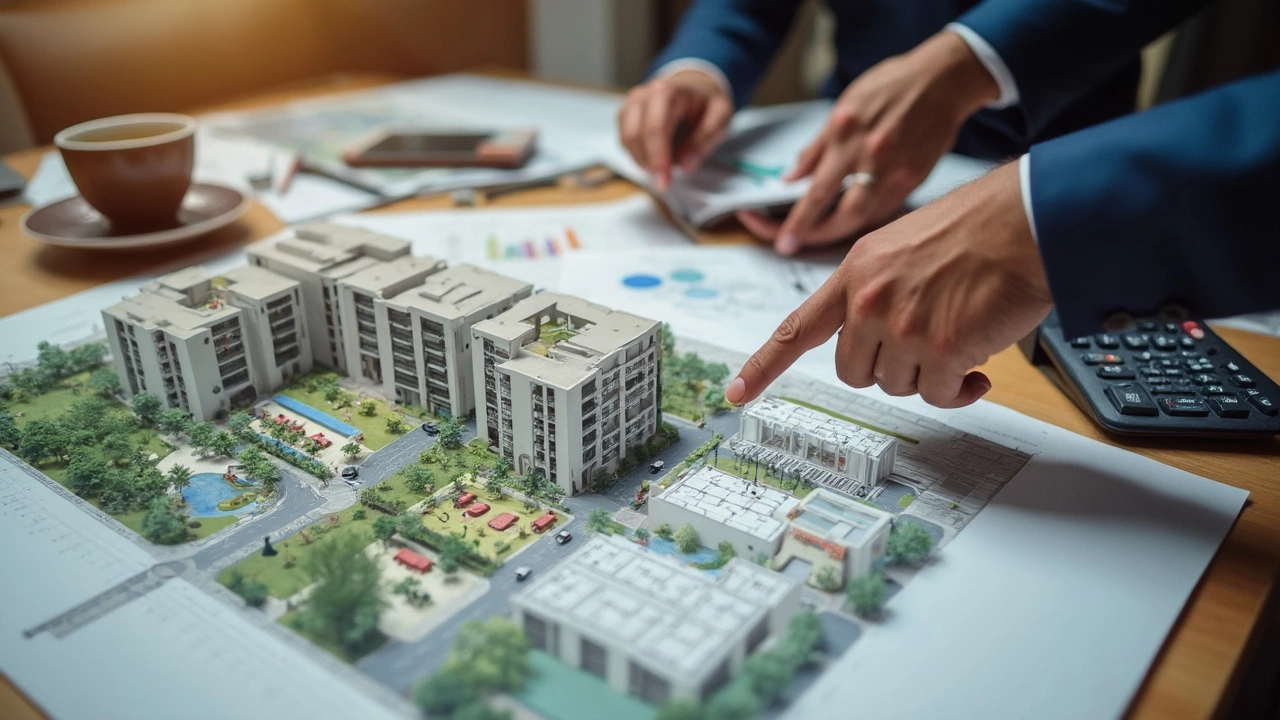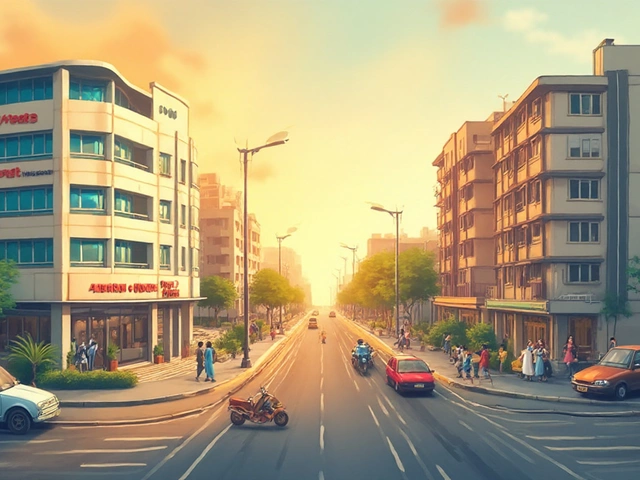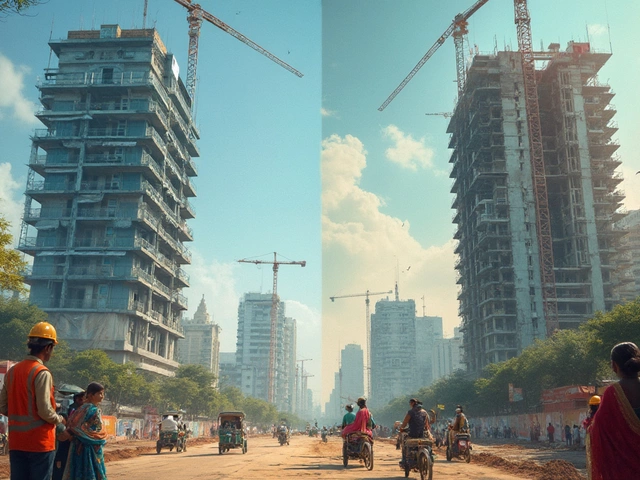Commercial or residential? It sounds like a simple choice, but dig a little deeper, and the story gets way more interesting. If you’re considering building, investing, or just curious about which side of the fence offers more bang for your buck, there’s a lot to unpack.
Let’s get right to what matters: commercial construction covers things like office buildings, retail spaces, and warehouses, while residential deals with homes and apartment buildings. The stakes—and the rewards—change depending on which path you pick. Some folks love the steady cash flow from a strip mall. Others prefer the security and demand of housing.
Here’s something you won’t read in most brochures: commercial projects often come with stricter regulations and higher up-front costs, but can also mean bigger, steadier income if you land a great tenant. Residential construction, on the other hand, usually means simpler rules and faster build times, but the return depends a lot on the market and who’s living in your building. Navigating these decisions boils down to knowing your own risk comfort, investment style, and just how much time you want to spend babysitting your property.
- Breaking Down the Basics
- Investment and Profit Potential
- Rules, Risks, and Timelines
- Long-Term Ownership Considerations
- Tips for Deciding What Suits You Best
Breaking Down the Basics
If you're picking between commercial construction and residential construction, it helps to know exactly what each type covers. Commercial means anything built for business use—office buildings, shopping centers, hotels, even self-storage units. Residential is all about places where people live, such as single-family homes, townhouses, and apartment buildings.
One key thing to remember is that commercial projects need more specialized skills and teams. Electrical, HVAC, and fire suppression systems in a commercial building are more complex than what you'd see in a house. You'll usually need architects, engineers, and a bunch of permits just to get off the ground.
- Commercial buildings are governed by stricter rules—think Americans with Disabilities Act (ADA) requirements, fire exits, and high-capacity plumbing.
- Residential codes focus more on family safety, like smoke alarms, railings, and local zoning rules. There's still paperwork, but not as much red tape as commercial.
Another thing: banks see these two project types very differently. Mortgages for homes are easier to get, but commercial loans? Higher interest, bigger down payments, and more paperwork. On average, a commercial loan down payment lands around 20-30%, while residential can be as low as 3-5% if you qualify for government programs.
| Aspect | Commercial | Residential |
|---|---|---|
| Approval Time | Longer (months) | Shorter (weeks to months) |
| Loan Down Payment | 20-30% | 3-5% |
| Inspection Requirements | More frequent, detailed | Standard, basic |
When you drive around your city, you’ll notice commercial spots tend to cluster in high-traffic areas, while homes sprawl out in quieter neighborhoods. That’s not random—location matters more for commercial construction. Businesses count on visibility and access, whereas most people buying a house focus on schools, parks, and noise levels.
Investment and Profit Potential
When you put your money into commercial construction, you’re generally playing for higher returns compared to residential. Office buildings, warehouses, and retail centers can attract long-term leases. Here’s the kicker: commercial tenants often sign on for 5–10 years, sometimes longer. That means less hassle finding new renters every year and steadier income streams. In 2024, the average return on investment (ROI) for commercial real estate in the US hovered around 9%-12%, depending on the sector.
Residential construction—think single-family homes, duplexes, or small apartment complexes—offers a different game. These projects typically cost less up front, and the rental market is usually more active. Turnover is higher, though, so you’re often hunting for new tenants every year or two. Average ROI for residential properties lands closer to 6%-8%. Not bad, but not hitting the highs you might see with a well-placed strip mall or office block.
There’s also a difference in how banks view your loan application. Lenders expect more cash down for commercial projects—think 20-30% of the total costs, compared to 10-20% for residential. They want to see seasoned investors, not first-timers.
| Type | Average ROI (2024, US) | Typical Lease Length | Upfront Investment |
|---|---|---|---|
| Commercial | 9% - 12% | 5 - 10 years | 20% - 30% down |
| Residential | 6% - 8% | 1 - 2 years | 10% - 20% down |
What’s the bottom line? Commercial usually wins on pure profit—if you have the capital, the patience, and can handle more complexity. Residential is less risky to start, especially in busy rental markets, and most people find it easier to get into. If you value fast turnover and hands-on management, residential might fit better. If you’re chasing bigger returns, commercial could be where you score.

Rules, Risks, and Timelines
If you’re jumping into commercial construction, expect way more rules than with residential projects. Local authorities want to keep the public safe, so there’s a mountain of regulations—think fire safety, elevator codes, accessibility standards (like ADA compliance), and energy codes. Every change in design often needs a new permit. Missing something? That can mean fines or costly delays. Getting inspections signed off can drag out the schedule, too.
Now, on the residential construction side, inspectors also want things safe, but the rules tend to be more straightforward. There are still building codes, but you’re usually dealing with fewer layers. Change your mind mid-build? It’s easier to pivot with a home or duplex than a 50,000 square foot office.
When it comes to risks, commercial projects usually mean betting big: You’re putting more cash on the line, and if you build before finding tenants, you could hold an expensive empty building for months or even years. Commercial properties are also more vulnerable to market ups and downs. Lose a tenant? The rent gap can wipe out months of profit. With residential buildings, vacancies usually mean smaller income gaps—a few empty apartments rarely break the bank compared to a vacant warehouse.
Timeline is a big deal, too. Commercial buildings often take much longer. They’re bigger, require more permits, and deal with slower supply chains. Residential builds (like single-family homes) can sometimes get finished in a matter of months.
| Project Type | Avg. Approval Time | Construction Duration |
|---|---|---|
| Commercial | 6-18 months | 12-36 months |
| Residential | 2-6 months | 4-12 months |
To sum up, commercial construction means more paperwork, higher risk, and longer build times. Residential construction comes with simpler red tape and a faster turnaround, but each option brings its own challenges depending on your goals, your budget, and your tolerance for risk. Going in with open eyes saves a whole lot of headaches down the road.
Long-Term Ownership Considerations
If you’re thinking about holding onto a property for years, there are some major differences between commercial construction and residential construction that go way beyond paint and flooring.
First up is property management. Commercial buildings—like offices and retail centers—often need more hands-on management. For example, you’ll deal with lease negotiations, tenant improvements, security upgrades, and regular inspections. If you have just one or two big tenants, losing one could hit your cash flow hard.
Residential properties, such as single-family homes or apartment blocks, usually involve shorter, more frequent leases. This means turnover is higher—people move more often than businesses. But here’s the flip side: even if a couple of tenants leave, you’re rarely staring at an empty building. Multifamily units spread your risk around.
| Factor | Commercial | Residential |
|---|---|---|
| Lease Length | 3-10 years typical | 1 year typical |
| Vacancy Risk | Higher if tenant leaves | Lower due to more units |
| Maintenance | Can be more complex & costly | Usually simpler |
Maintenance is another big one. Large HVAC systems, specialty lighting, elevator checks—commercial spaces can eat up your repair budget if you’re not prepared. Residential buildings aren’t maintenance-free, but the scale and specialization usually aren’t quite as wild.
Insurance is next. Policies for commercial buildings cost more and can have more restrictions (think: liability, business interruption, disasters). Residential insurance is generally easier to secure and cheaper per square foot.
One more thing: market cycles. Commercial properties tend to react more to changes in the economy—office and retail space can sit empty during downturns, while residential demand often bounces back faster. If you’re in for the long haul, think about how comfortable you are riding out slower years before things pick up again.

Tips for Deciding What Suits You Best
Trying to choose between commercial construction and residential construction? Here’s what you really need to look at before making your move.
First, get honest about your budget and how much risk you’re cool with. Residential projects often come with a lower entry cost and less complicated financing. Local banks love to back single-family homes and small multi-unit projects. On the flip side, commercial construction can mean financing hurdles and higher down payments—banks usually want you to have serious skin in the game, often 20-30% cash upfront.
Think about timeframes. Commercial builds easily drag out for 12-24 months (sometimes longer for big stuff like hospitals or shopping centers). Residential builds? You might be done in 4-12 months if all goes well.
Next up: rules and headaches. Commercial projects bring a maze of zoning laws, ADA requirements, and environmental reviews. Residential rules are usually more straightforward, but don’t ignore them—HOA requirements and city permits can still trip you up.
Let’s talk returns. Commercial tenants usually sign longer leases—think 3 to 10 years. That’s a stable income if you land the right crowd, but when vacancies hit, it can take forever to fill the space. Residential rentals turn over more often, but there’s also a bigger pool of renters looking for homes, especially in growing cities.
- If you want less hands-on management, consider triple-net commercial leases where tenants handle maintenance and property taxes.
- For easier entry and fewer surprises, stick with small-scale residential construction. You can always scale up later.
- If you’re looking to diversify, mix it up—many seasoned investors keep a blend of both types in their portfolio.
Check stats from the National Association of Realtors: as of 2024, average vacancy rates for U.S. office buildings hovered around 16%, while multifamily residential sat near 6%. Lower vacancy means steadier income, but watch for location-specific trends.
| Type | Avg. Vacancy Rate | Typical Lease Length |
|---|---|---|
| Commercial (Office) | 16% | 5+ years |
| Residential (Multifamily) | 6% | 1 year |
Bottom line—if you like steady, long-term deals and can stomach bigger risks for bigger rewards, commercial might be your lane. If you’d rather keep things familiar, flexible, and manageable, residential is your friend. Don’t forget to weigh how much time you want to spend managing tenants and repairs—some folks love it, others can’t stand the hassle.




Write a comment